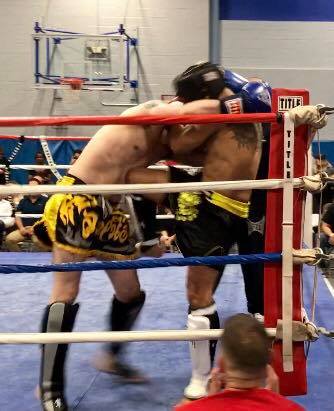
It’s not easy to become a well-rounded martial artist. There are so many different positions in hand-to-hand combat, so many different styles, different body types and strategies. It takes time and dedication towards multiple disciplines to be a competent mixed martial artist. One must study and practice striking and grappling. Understanding the intricacies of Brazilian Jiu-Jitsu, wrestling, and judo whilst practicing boxing and Muay Thai can seem like a lot; but it’s a necessary education for any aspiring mixed martial artist. Although specialists such as Khabib Nurmagomedov and Israel Adesanya have had tremendous success, well-rounded martial artists seem to have the most longevity in the sport. Even as a specialist you must train in everything. Although Khabib comes from a wrestling background, he uses his striking to create entries for his takedowns.

One of the more frequently overlooked areas of mixed martial arts training takes place somewhere between the realms of striking and grappling. The Thai Clinch is a versatile combat tool which involves a combatant grabbing onto their opponent while standing and manipulating their balance to create opportunities to land strike. As is consistent with most martial arts techniques, the clinch is not something that should be forced. Your entry into clinch distance is important, many eager fighters have been knocked out by running forward in hopes of grabbing onto their opponent.
In the video above, Coach Karl Nemeth shows us some of his favorite entries to the clinch. For the sake of explanation, we’ll be using the Japanese terms “uke” and “tori” to describe the roles that each partner will be playing when drilling these sequences. Karl will be the “tori”; or the person who completes the technique, whereas his partner will be referred to as the “uke”; or the person who receives the technique. The first entry that Karl demonstrates is in response to his ukes jab. As uke fires his jab, Karl parries with his rear hand and hooks onto ukes jab hand. Karls lead hand finds ukes head as he throws his left knee to his ukes body. Karl manages to throw his lead knee with significant power due to executing a switch step. As he reaches his left hand to grab his ukes head, he switches his left and right foot placement. He began the sequence with his left foot in front and right foot in back. As he grabs the head, he brings the left foot back and the right foot slightly forward; loading for a devastating left knee. From here he details moving into a side clinch, where he pummels his hand that originally parried the jab into an underhook as he circles towards ukes lead side.

Karls next clinch entry starts with his own attack. Instead of waiting for uke to throw, Karl begins to initiate with his own kick. He throws a switch step kick (very similar motion to the switch step knee that we looked at earlier). This gives Karl some information on how his opponent will react. Many will check the kick, some may try to catch, some may just eat the kick; we just need some sort of reaction. Karl then fakes his lead kick by hopping in and lifting his lead foot in order to get uke to react or brace for the kick. As his feet land in range, Karl grabs onto ukes head with his rear hand and ukes arm with his lead hand, pulling him into knees once again. Depending on his opponents reaction, Karl may be able to get a sweep from here. If the opponents posture begins to buckle from the knees, just keep hitting him. However, an experienced fighter will usually have the composure to bring their hips in and keep a good posture to prevent more knees from landing. As the uke is bringing his hips in, Karl fires a right knee, then uses his right foot to block ukes shin as Karl quarter turns, bringing his head off line and compromising ukes balance. Karl then proceeds to show how we can use these entries with a variety of our opponents punches or our own kicks from either side.
A uniquely well-rounded martial artist, Coach Karl has trips, dumps, sweeps and takedowns from pretty much any position. Amongst all of these options, the knee-bump is something that Karl has been terrorizing his students and training partners with for years. Karl details three of his favorite knee bumps in the video above. Starting with a right side collar tie and left hand grabbing the arm, Karl steps his right foot forward, bringing the inside of his right knee to the outside of ukes left knee. As Karls right knee pushes in to the left, buckling ukes left knee, Karl uses his collar tie to pull to the right, bringing uke to the mats. In his next example, Karl uses his left hand to grab a collar tie while his right hand grabs the arm to steer his opponent to the left. The footwork is slightly different as well. Instead of stepping to the outside of his ukes lead leg, Karl steps to the inside. This time Karl brings the outside of his right knee to the inside of ukes left knee; using it to open up ukes stance as he pulls them to the left with his collar tie. The key to all of these is to establish force going in opposite directions. In this example, Karl uses his knee to push his opponents knee out to the right while pulling their head to the left using the collar tie grip. Karls third variation involves a right side collar tie with the left hand on the arm just like the first knee-bump. This time he pulls the uke’s head to the right and he steps to the left, bumping the inside of his uke’s right knee with the inside of his right knee. Although it may not necessarily bring the uke to the ground, this variation is great for disrupting balance to set up for knees and other strikes.

Want to master the Thai clinch? Come check out Precision Boxing and MMA; the Hudson Valley’s premiere mixed martial arts academy. Give us a call today at (845)392-8495 or click HERE!
About the Author
Oliver Swanson is a lifelong Hudson Valley resident and avid martial arts practitioner. Teaching boxing classes in Poughkeepsie six days a week and working as a NASM certified personal trainer, he has established his life around martial arts and fitness. When he’s off the mats he loves spending time with his family and dogs Vivian and Max.

